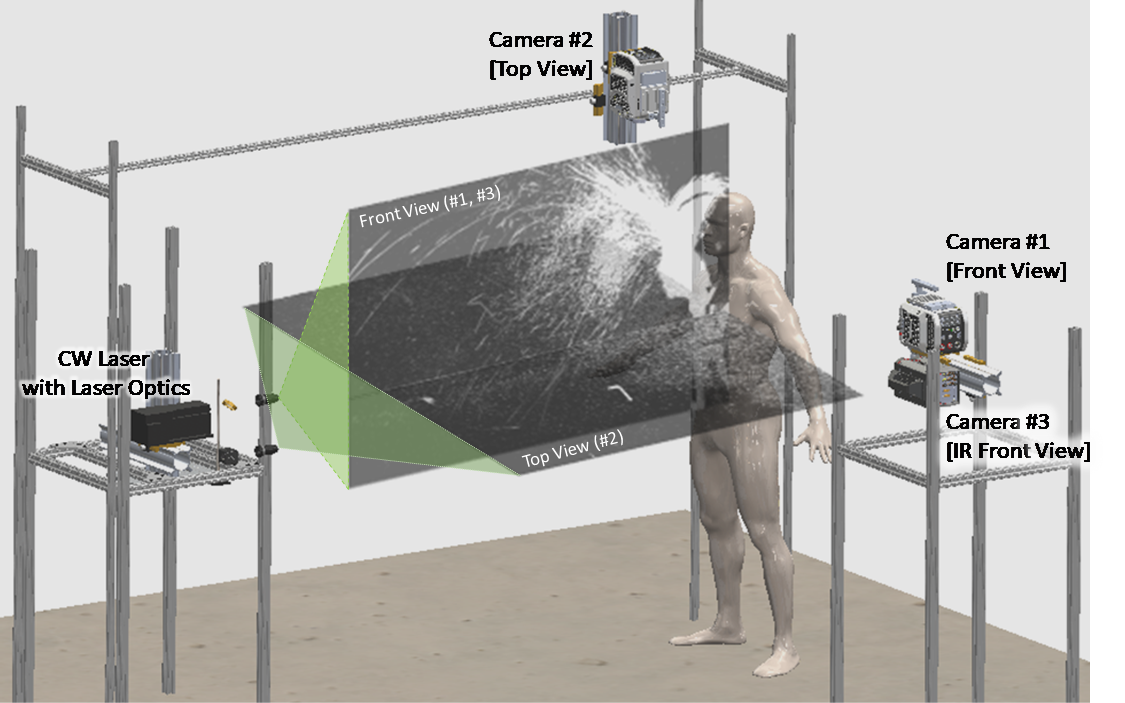Researchers at the Thermal Hydraulics Research Laboratory have conducted experiments and computational fluid dynamics (CFD) simulations investigating the dynamics of a human sneeze.
Objectives
Droplets and aerosols ejected during the human sneeze possibly contains infectious pathogens.
Understanding of the mechanisms of airborne droplet transmission during sneezing is important in the spread of the viruses. The multiphase fluid flow of the transport, dispersion and evaporation of ejected saliva droplets during sneezing is investigated.
Methods
In present study, we have been investigating the human sneeze experimentally by taking advantage of the state-of-the-art high-speed cameras and an infrared (IR) camera. Image processing based laser-diagnostics techniques including Particle Image Velocimetry (PIV) and Particle Tracking Velocimetry (PTV) were employed to characterize flow dynamics of the human sneeze.

Figure 1: Experimental configuration to capture the high-speed videos of droplets and aerosol spreading during a human sneeze – 3D cad drawing

Figure 2: Experimental configuration to capture the high-speed videos of droplets and aerosol spreading during a human sneeze – snapshots
Results
Following video presents the human sneeze captured by 4 cameras simultaneously.
From the Schlieren image (Camera #4), many droplets captured farther than 2 m (about 2.4 m from the source of sneeze) as shown in the Figure 3.
 Figure 3. Accumulated droplets trajectories captured on the Schlieren video (Camera #4)
Figure 3. Accumulated droplets trajectories captured on the Schlieren video (Camera #4)
This implies that the 2 m (6 ft) social distance may not be enough in the case someone infected sneezes without proper coverings.
Here comes another videos with close up view near the mouth:
In the close up views, the sneeze clouds (aerosols) are captured with the large size droplets.
The following movie was recorded in presence of theatrical fog which shows the structure of the sneeze cloud more clearly.
From the high speed video captured from the Camera #1, velocity vectors were calculated using PIV and PTV algorithms.
PIV
PTV
The PIV results are calculated by PIVlab toolkits (William Thielicke (2020). PIVlab – particle image velocimetry (PIV) tool (https://www.mathworks.com/matlabcentral/fileexchange/27659-pivlab-particle-image-velocimetry-piv-tool), MATLAB Central File Exchange. Retrieved June 17, 2020.).
And the PTV results are calculated by PTVresearch toolkits (Jonathan Higham (2020). PTVResearch (https://www.github.com/jonnyhigham/PTVResearch), GitHub. Retrieved June 17, 2020.)
The following videos present the CFD simulation results of the human sneeze. Human factors extracted from the experimental results are incorporated for the simulations. (Credits: Giacomo Busco)
Conclusions
The series of the high-speed videos provides many insights to better understand the human sneeze process. Obtained the realistic sneeze dynamics can help to develop a better computational model of the human sneeze to investigate the droplets spreading in more complex scenarios. One possible case could be many people sneeze in public indoor space with HVAC system such as a class room, restaurant, and restroom.
